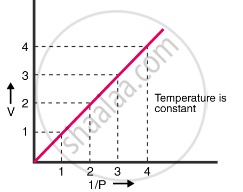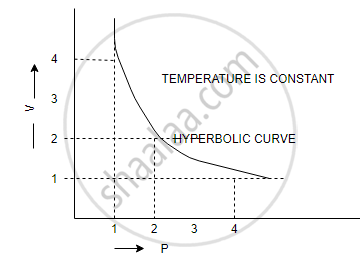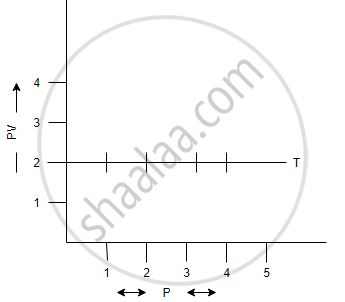Advertisements
Advertisements
Question
Give its
(i) mathematical expression
(ii) graphical representation and
(iii) significance.
Solution
(i) mathematical expression
suppose a gas occupies volume V1 when its pressure is P1; then
`"V"_1 ∝ 1/"P"_1 "or" "V"_1 = "k"/"P"_1`
`"P"_1"V"_1 = "k" = "constant"`
If V2 is the volume ocuupied when the pressure is P2 at the same temperature, the
`"V"_2 ∝ 1/"P"_2 "or" "V"_2 = "k"/"P"_2`
`"P"_2"V"_2 = "k" = "constant"`
`"P"_1"V"_1 = "P"_2"V"_2 = "k"` at constant temperature.
This is called Boyle's law equation.
(ii) graphical representation
The law can be verified by plotting a graph
(a) V vs `1/p` (b) V vs P (c) PV vs P
(a) V vs `1/p`: a straight line passing through the origin is obtained

(b) V vs P: a hyperbolic curve in the first quadrant is obtained

(c) PV vs P: a straight line is obtained parallel to the pressure axis.

(iii) Significance
On increasing pressure, volume decreases. The gas becomes denser. Thus at a constant temperature, the density of a gas is directly proportional to its pressure.
Atmospheric pressure is low at high altitudes, so air is less dense. Hence, a lesser quantity of oxygen is available for breathing. This is the reason why mountaineers have to carry oxygen cylinders with them.
APPEARS IN
RELATED QUESTIONS
Choose the correct answer:
If the pressure is doubled for a fixed mass of a gas, its volume will become
A gas at 240 K is heated to 127°C. Find the percentage change in the volume of the gas (pressure remaining constant).
A certain mass of a gas occupies 2 litres at 27°C and 100 Pa. Find the temperature when volume and pressure become half of their initial values.
Calculate the volume occupied by 2 g of hydrogen at 27°C and 4-atmosphere pressure if at STP it occupies 22.4 litres.
State Boyle's Law.
A given mass of a gas occupied 143 cm3 at 27° C and 700 mm Hg pressure. What will be its volume at 300 K and 280 mm Hg pressure?
Calculate the volume of a gas ‘A’ at s.t.p., if at 37°C and 775 mm of mercury pressure, it occupies a volume of `9 1/2` litres.
Assuming temperature remaining constant calculate the pressure of the gas in the following:
The pressure of a gas having volume 1000 cc. originally occupying 1500 cc. at 720 mm. pressure.
Assuming temperature remaining constant calculate the pressure of the gas in the following:
The pressure of a gas having volume 100 lits. originally occupying 75 dm3 at 700 mm. pressure.
Calculate the coefficient of cubical expansion of a zinc bar. Whose volume is increased 0.25 m3 from 0.3 m3 due to the change in its temperature of 50K?
